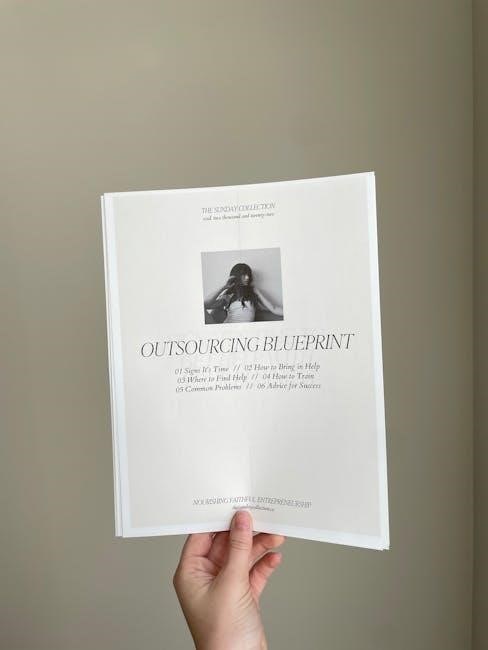Booklets and manuals are essential printed materials designed to convey specific information. Booklets are concise, often used for promotional or instructional purposes, while manuals provide detailed guidance.
Definition and Overview
A booklet is a small, thin book with a limited number of pages, typically ranging from 8 to 36 pages. It is designed to provide concise, focused information on a specific topic, such as promotional materials, instructional guides, or event programs. Booklets are often used for their portability and ease of reading. Manuals, on the other hand, are detailed instructional documents that provide comprehensive guidance on complex topics. They are commonly used for technical processes, product operation, or training purposes. While booklets prioritize brevity and clarity, manuals emphasize depth and precision, making them indispensable for tasks requiring step-by-step instructions. Both formats serve distinct purposes, catering to different audiences and needs.

Physical Differences Between Booklets and Manuals
Booklets are smaller, with fewer pages (typically up to 36), and often use saddle stitching. Manuals are larger, with more pages, and may use perfect or spiral binding.
Size and Page Count
Booklets are typically smaller and thinner, with fewer pages, usually ranging from 8 to 36 pages. Their compact size makes them easy to handle and skim. Manuals, in contrast, are larger and thicker, often containing 50 pages or more, depending on the complexity of the subject matter. The size difference is also reflected in their dimensions, with booklets commonly measuring 5.5 x 8.5 inches, while manuals can be as large as 8.5 x 11 inches. This physical distinction aligns with their purposes, as booklets are designed for concise, focused content, whereas manuals provide extensive, detailed information. The page count and size ensure each format serves its intended use effectively.
Binding and Cover Type
Booklets and manuals differ significantly in binding and cover types due to their intended use. Booklets often utilize saddle-stitching, a cost-effective method where pages are stapled together along the spine. This binding is ideal for smaller, thinner documents. Manuals, on the other hand, frequently use perfect binding or spiral binding, which are more durable and suitable for thicker, longer-lasting materials. Covers also vary: booklets typically have lightweight covers, often made of paper or thin cardboard, sometimes with vibrant designs to grab attention. Manuals feature heavier, more robust covers, sometimes laminated or made of plastic, ensuring longevity and protection from wear and tear. These design choices reflect the differing purposes and audiences of booklets and manuals.

Content Differences

Booklets and manuals differ in content purpose. Booklets provide concise, focused information for quick reference, while manuals offer detailed, step-by-step instructions for complex tasks;

Depth of Information
Booklets and manuals vary significantly in the depth of information they provide. Booklets are concise, offering brief overviews or summaries of topics, making them ideal for quick reference. Manuals, however, are comprehensive, detailing step-by-step instructions, technical specifications, and in-depth explanations. While booklets focus on simplicity and ease of understanding, manuals cater to users needing detailed guidance for complex tasks or systems. This difference in depth ensures that booklets are accessible for general audiences, whereas manuals serve professionals or individuals requiring precise, actionable information. The level of detail in manuals often includes troubleshooting tips, diagrams, and technical jargon, distinguishing them from the more straightforward content of booklets.

Target Audience and Purpose

Booklets and manuals are tailored to distinct audiences and serve specific purposes. Booklets are designed for broad audiences, often aiming to inform or persuade. They are commonly used for promotional materials, such as product catalogs, brochures, or instructional guides, making them accessible to the general public. Manuals, on the other hand, target specific groups, like professionals, technicians, or enthusiasts, who require detailed operational guidance. Manuals focus on providing clear, step-by-step instructions for complex tasks or machinery. The purpose of a booklet is to deliver concise, focused information, while manuals aim to equip users with the knowledge needed to perform specific tasks effectively. This differentiation ensures that each format meets the unique needs of its intended audience.

Purpose and Use Cases
Booklets serve as concise informational tools, ideal for promotional materials or quick guides, while manuals provide detailed instructions for complex tasks, ensuring effective operation or understanding.
Booklets: Focus on Concise Information
Booklets are designed to deliver concise and focused information, making them ideal for quick reference or overview materials. Typically ranging between 8 to 50 pages, they are smaller and more digestible than manuals, emphasizing clarity and brevity. Common uses include promotional materials, instructional guides, and informational brochures. Their compact size and limited page count ensure that content is streamlined, avoiding unnecessary details. Booklets are often used for marketing purposes, such as product catalogs or event programs, as well as for providing straightforward instructions or overviews. Their design prioritizes ease of reading, with clear visuals and formatting that enhance understanding. This makes them perfect for audiences seeking immediate, actionable information without the depth of a full manual.
Manuals: Detailed Instructions and Guidelines
Manuals are comprehensive documents designed to provide detailed instructions and guidelines for complex tasks, systems, or products. Unlike booklets, manuals are lengthy, often containing hundreds of pages, and are structured to offer in-depth information. They are typically used for technical purposes, such as operating machinery, software, or equipment. Manuals cater to professionals, technicians, or users requiring detailed knowledge to perform specific functions. Their content is highly organized, with chapters, sections, and appendices to ensure accessibility. Manuals may include diagrams, troubleshooting guides, and reference materials, making them indispensable for mastering intricate processes. Their primary goal is to empower users with the knowledge needed to achieve proficiency and compliance, serving as an essential resource for both routine and specialized tasks.

Design and Layout Considerations

Booklets and manuals require careful design to enhance readability. Booklets use visuals and concise text, while manuals focus on clear typography and structured layouts for complex information.
Visual Elements and Formatting
Visual elements and formatting play a crucial role in both booklets and manuals. Booklets often incorporate high-quality images, infographics, and vibrant colors to engage readers, while manuals rely on clear typography and consistent formatting to ensure readability. Proper use of headings, subheadings, and bullet points helps organize complex information in manuals. Booklets may include illustrations or charts to simplify concepts, whereas manuals often use diagrams and flowcharts for step-by-step instructions; Sufficient white space is essential in both to avoid clutter, ensuring content remains accessible. Additionally, page numbering and indexes in manuals aid navigation, while booklets focus on visually appealing layouts to maintain reader interest and convey concise information effectively.
Booklets and manuals serve distinct purposes, with booklets offering concise, visually engaging content and manuals providing detailed, practical guidance. Understanding their differences helps tailor communication effectively.
Key Takeaways
Booklets and manuals differ significantly in size, content, and purpose. Booklets are smaller, with fewer pages, often used for concise information like promotional materials or short guides. Manuals, however, are larger and more detailed, providing in-depth instructions for complex tasks or products. The choice between the two depends on the audience and the level of detail required. Booklets are ideal for quick reference or marketing, while manuals are essential for technical guidance. Understanding these distinctions ensures effective communication and proper utilization of each format. Both serve unique roles in conveying information, making them indispensable in various industries and contexts.